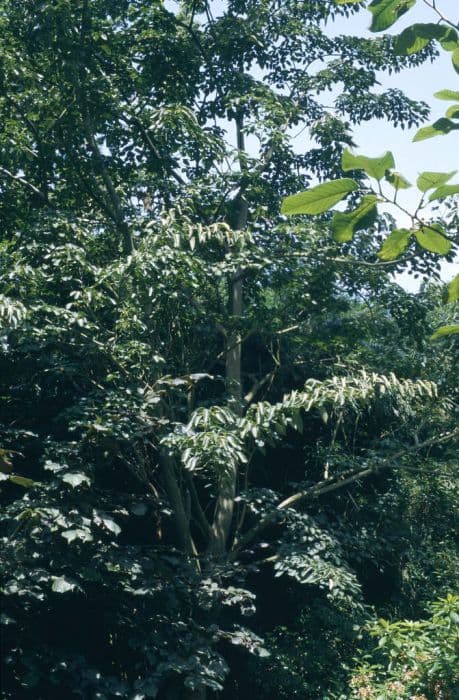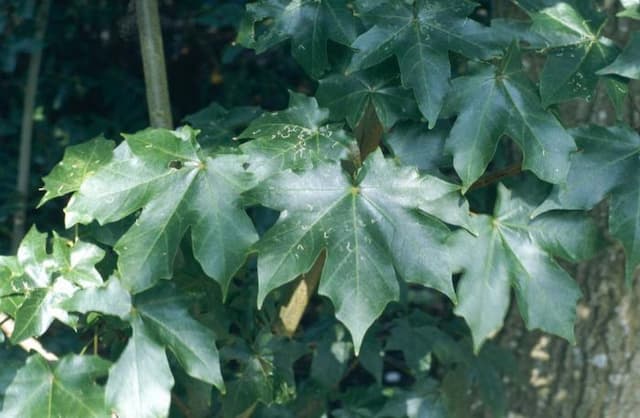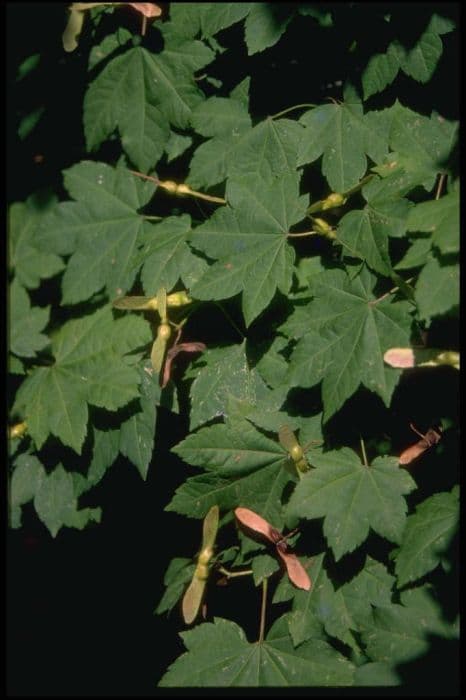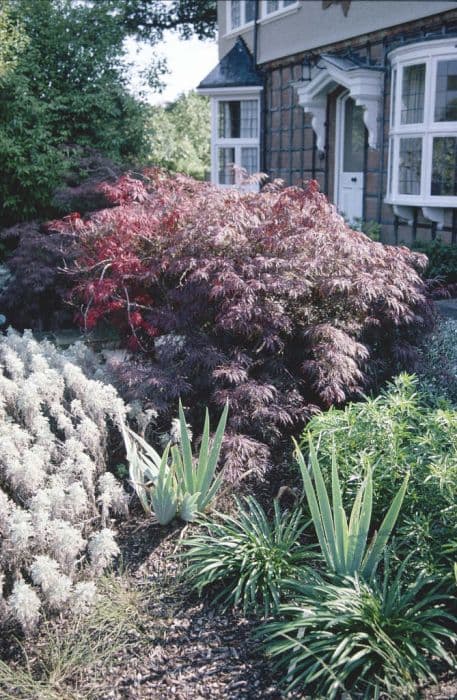Japanese Maple Acer palmatum 'Skeeter's Broom' (Dw)

ABOUT
Acer palmatum 'Skeeter's Broom', commonly known as Japanese maple, is a strikingly ornamental plant coveted for its captivating foliage and elegant growth habit. This variety, with its compact form, features pointed, slender leaves that resemble the delicate form of a palm, giving rise to the species' common name. The leaves are deeply lobed, often with five to seven elongated and serrated segments that emerge with a fiery red hue in the spring. As the seasons transition, the leaves of the Japanese maple undergo a magical transformation in color. The springtime red deepens to a rich, burgundy tone during the summer, offering a continuous display of vivid color against the contrasting greenery of its garden companions. Then, as autumn approaches, the foliage ignites once more into an intense display of bright red, creating a breathtaking visual effect that is a highlight in any landscape. The branching pattern of 'Skeeter's Broom' is aesthetically pleasing; the branches grow in an upright fashion, contributing to its neat and tidy profile. It tends to have a dense canopy, with the lush foliage providing a full-bodied presence that can serve as an excellent focal point or a graceful accent in various garden settings. The texture and color of 'Skeeter's Broom' come together to craft a sophisticated and refined appearance, making it a highly desirable choice for those seeking to add a touch of elegance and dramatic flair to their outdoor spaces.
About this plant
 Names
NamesFamily
Sapindaceae
Synonyms
Japanese Maple, Skeeter's Broom
Common names
Acer palmatum 'Skeeter's Broom'
 Toxicity
ToxicityTo humans
Japanese maple, including the 'Skeeter’s Broom' cultivar, is generally not considered toxic to humans. While it is not meant for ingestion and the level of toxicity is low, consuming parts of the plant typically does not result in poisoning or serious health concerns for humans.
To pets
Japanese maple, which includes the variety known as 'Skeeter's Broom', is also not considered toxic to pets. It is not associated with serious health risks if pets were to ingest leaves or other parts of the plant. However, any non-food plant material can potentially cause mild stomach upset if ingested in large quantities.
 Characteristics
CharacteristicsLife cycle
Perennials
Foliage type
Deciduous
Color of leaves
Red
Height
5 feet [1.5 meters]
Spread
4 feet [1.2 meters]
Plant type
Shrub
Hardiness zones
5
Native area
Japan
Benefits
 General Benefits
General Benefits- Ornamental appeal: The 'Skeeter's Broom' is a Japanese Maple cultivar prized for its beautiful red foliage and attractive form, making it a focal point in any garden or landscape.
- Compact size: This dwarf variety stays relatively small, which means it fits well into smaller gardens or spaces where a full-size Japanese Maple would be too large.
- Seasonal interest: The leaves of this plant offer a visual spectacle with colors changing from spring through fall, creating a dynamic and shifting display in the garden.
- Shade tolerance: Like many Japanese Maples, 'Skeeter's Broom' can grow in partial shade, providing flexibility in garden design and plant placement.
- Low maintenance: Once established, this variety of Japanese Maple requires minimal pruning and care, making it a convenient choice for busy gardeners.
- Drought resistance: Although it prefers consistent moisture, 'Skeeter's Broom' can tolerate periods of drought, making it suitable for various climate conditions.
- Cold hardiness: This cultivar is relatively hardy and can withstand cooler temperatures, making it appropriate for a wide range of geographic locations.
 Medical Properties
Medical PropertiesThis plant is not used for medical purposes.
 Air-purifying Qualities
Air-purifying QualitiesThis plant is not specifically known for air purifying qualities.
 Other Uses
Other Uses- Photography: Acer palmatum 'Skeeter's Broom' provides a striking backdrop for photographers during the fall season due to its vibrant red foliage.
- Bonsai: Due to its small leaves and attractive branching pattern, this maple variety is particularly well-suited for bonsai cultivation.
- Container Gardening: This dwarf variety can be grown in containers to decorate balconies, patios, or even as indoor ornamentals with adequate lighting.
- Education: Horticulture and botany programs often use Acer palmatum varieties to teach plant grafting techniques and cultivar development.
- Art Inspiration: The unique form and seasonal color changes of 'Skeeter's Broom' make it an excellent subject for artists and designers seeking natural inspiration.
- Wedding Decor: Because of its elegant appearance, branches can be used in wedding arrangements or venue decorations, particularly in autumn celebrations.
- Feng Shui: The maple's structure and fall color is thought to bring positive energy into a space according to Feng Shui principles.
- Culinary Presentation: At high-end culinary events, chefs sometimes use the colorful leaves as a natural garnish or plate decoration to enhance the presentation of their dishes.
- Wildlife Shelter: Though domesticated, the dense foliage can still provide shelter for birds and beneficial insects within a garden ecosystem.
- Film and Theatre: The vibrant appearance and compact size of Acer palmatum 'Skeeter's Broom' make it a favored choice for set design, particularly in outdoor scenes or staged garden settings.
Interesting Facts
 Feng Shui
Feng ShuiThe Japanese Maple is not used in Feng Shui practice.
 Zodiac Sign Compitability
Zodiac Sign CompitabilityThe Japanese Maple is not used in astrology practice.
 Plant Symbolism
Plant Symbolism- Beauty and Grace: The Japanese Maple, which includes the 'Skeeter's Broom', is often associated with beauty and grace due to its elegant structure and the changing colors of its foliage throughout the seasons.
- Peace and Tranquility: Japanese gardens often feature Japanese Maples as they are thought to create a peaceful and tranquil atmosphere, making them symbolic of these states of being.
- Balance and Practicality: With its finely cut leaves and balanced shape, 'Skeeter's Broom' embodies the Japanese aesthetic of creating harmony, suggesting a symbolic meaning of balance and practical beauty.
- Endurance and Change: Since the Japanese Maple withstands changing seasons with vibrant color shifts, it often represents endurance and the welcoming of change.
 Water
WaterThe Japanese Maple 'Skeeter's Broom' should be watered deeply once a week, providing that the top couple inches of soil have dried out; more frequent watering may be necessary during hot, dry periods. It is essential to avoid waterlogging, so ensure proper drainage. Typically, a young tree requires about 10 gallons of water per week, but this can vary based on the size of the tree and the environmental conditions. During the winter, when the tree is dormant, reduce the watering frequency.
 Light
LightJapanese Maple 'Skeeter's Broom' thrives best in a spot that gets morning sun and afternoon shade to protect it from the harsh midday sun. Ideally, it should receive about four to six hours of filtered sunlight daily. The perfect lighting condition helps prevent leaf scorch and encourages vibrant leaf color.
 Temperature
TemperatureJapanese Maple 'Skeeter's Broom' can tolerate a range of temperatures but does best in zones where the temperature does not routinely drop below -10 degrees Fahrenheit or exceed 90 degrees Fahrenheit. The ideal temperature range for this tree is between 60 and 80 degrees Fahrenheit.
 Pruning
PruningPrune the Japanese Maple 'Skeeter's Broom' to maintain its shape and size, remove any dead or crossing branches, and to improve air circulation. The best time for pruning is in the late winter or early spring before new growth starts. It needs to be pruned minimally, generally not more than once per year, to maintain the tree's natural form.
 Cleaning
CleaningAs needed
 Soil
SoilJapanese Maple 'Skeeter's Broom' thrives in well-draining soil rich in organic matter with a pH of 5.5 to 6.5. A mix of loam, peat moss, and perlite or pine bark can provide the right conditions for healthy growth.
 Repotting
RepottingJapanese Maple 'Skeeter's Broom' should be repotted every 2-3 years to prevent root bounding and to refresh the soil, ensuring its health and vigour.
 Humidity & Misting
Humidity & MistingJapanese Maple 'Skeeter's Broom' prefers moderate humidity levels but is adaptable to the lower humidity found in typical outdoor environments in its growing zones.
 Suitable locations
Suitable locationsIndoor
Bright indirect light, no drafts, higher humidity.
Outdoor
Part shade, sheltered from strong winds, well-drained soil.
Hardiness zone
5-8 USDA
 Life cycle
Life cycleJapanese Maple 'Skeeter's Broom' begins its life as a seed, which germinates in favorable conditions of moist, well-drained soil and partial to full sunlight. After sprouting, the seedling gradually develops into a young sapling, exhibiting characteristic reddish-purple leaves that mature alongside its growth. As it enters the juvenile phase, the maple undergoes vigorous growth, developing a more defined structure and branching habit. Reaching maturity, 'Skeeter's Broom' forms a compact, upright small tree with a dense canopy of deeply lobed leaves that provide seasonal interest with colors transitioning from purple in spring, to green in summer, and then to fiery reds and oranges in autumn. In its reproductive stage, the mature tree produces small purple-red flowers that give way to winged samaras, facilitating the spread of seeds to propagate the next generation. The Japanese Maple 'Skeeter's Broom' can enjoy a lifespan of several decades with proper care, eventually completing its life cycle when it succumbs to environmental stressors, diseases, or old age.
 Propogation
PropogationPropogation time
Early Spring
The Japanese Maple 'Skeeter's Broom' is typically propagated by softwood cuttings, a process best undertaken in late spring or early summer when new growth is still flexible but has begun to mature. To do this, a gardener would take a cutting of about 4 to 6 inches (10 to 15 centimeters) from a healthy branch, making sure it contains at least two or three sets of leaves. The cut should be made just below a leaf node, and the bottom leaves are removed. The cutting is then dipped in a rooting hormone to facilitate root development and planted in a well-draining soil mix. It's important to keep the soil consistently moist and the cuttings out of direct sunlight until roots have established, which can be verified by gently tugging on the cutting to feel for resistance.









